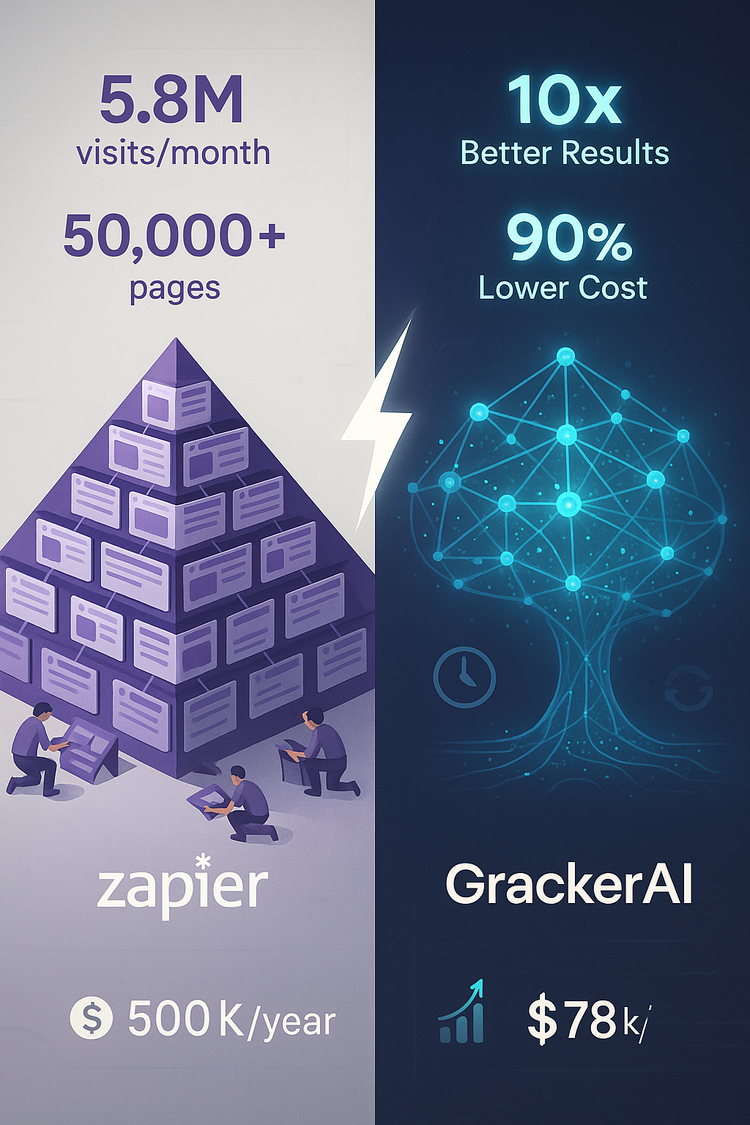The Data-Driven Approach to Unlocking Organic Growth

Programmatic SEO (pSEO) is a potent, scalable strategy that’s rewriting the rules of content marketing and search engine optimization. While it’s often associated with B2C giants like TripAdvisor, Yelp and Amazon, its applications are far broader and increasingly relevant to B2B businesses seeking to expand their digital footprint.
What is Programmatic SEO?
At its core, pSEO is the process of automating the creation and optimization of a large number of landing pages, each tailored to target specific keywords and phrases. It leverages data-driven insights and templated frameworks to streamline content production, ensuring maximum efficiency and search engine visibility.
The Mechanics of pSEO
The programmatic SEO workflow typically involves the following steps:
- Keyword Research: Identify a vast pool of relevant, often long-tail keywords with lower competition and higher intent. This research is typically data-driven, utilizing tools like SEMrush or Ahrefs to uncover opportunities.
- Template Development: Design a flexible template that maintains consistent elements (header, footer, branding) while allowing for dynamic content insertion. This template will serve as the foundation for your landing pages.
- Data Integration: Connect your pSEO platform to relevant data sources, such as product databases, internal knowledge bases, or APIs that pull in external information (e.g., location data, reviews, industry reports).
- Content Generation: Using scripts or algorithms, automatically populate your landing pages with relevant content based on the target keyword. This content could be product descriptions, comparison charts, location-specific information, or any data that aligns with the user’s search intent.
- Optimization: Ensure each page is thoroughly optimized for its target keywords. This includes optimizing title tags, meta descriptions, header tags, image alt text, and internal linking structure.
- Publication and Indexing: Publish your landing pages and submit sitemaps to search engines to ensure they get indexed quickly.
- Monitoring and Refinement: Continuously track the performance of your programmatic pages, analyzing metrics like click-through rates, bounce rates, and conversions. Use these insights to refine your strategy and optimize your content for maximum impact.
Driving Organic Growth: The pSEO Advantage
Programmatic SEO offers several key benefits that make it a powerful tool for driving organic growth:
- Scalability: pSEO enables the creation of thousands of landing pages efficiently, allowing you to target a wide range of keywords and capture long-tail search traffic.
- Relevance: By dynamically inserting relevant content, each page is highly targeted to the user’s search intent, increasing the likelihood of ranking well in search results.
- Efficiency: Automation streamlines content production, saving time and resources compared to manual creation.
- Agility: pSEO allows you to quickly adapt to changing trends and user preferences by updating data sources or tweaking templates.
- Data-Driven Optimization: Continuously monitor performance metrics to refine your strategy and maximize organic traffic.
pSEO in the B2B Landscape
While often associated with B2C e-commerce, pSEO can be equally effective for B2B companies. Here’s how:
- Target B2B-Specific Keywords: Focus on long-tail keywords relevant to your industry, products, or services (e.g., “best CRM software for healthcare,” “top enterprise project management solutions”).
- Content Focus: Craft landing pages that address the specific pain points and challenges faced by your target B2B audience. Offer solutions, resources, and in-depth information that resonate with their business needs.
- Data Sources: Leverage internal data (customer testimonials, case studies, product specs) and external data (industry reports, competitor analyses) to create informative and engaging content.
Examples of Successful B2B pSEO Implementations:
- HubSpot: HubSpot leverages pSEO to create dynamic landing pages for various marketing topics, catering to different user needs and search queries.
- Zapier: Zapier has created thousands of pages dedicated to tool integrations (e.g., “Google Sheets + [platform] integration”). These pages often contain dynamically inserted data about the integrations, tutorials, and user guides.
- G2: The software review platform uses pSEO to generate pages for thousands of software categories and subcategories, providing users with comprehensive comparisons and insights.
The Future of Content Marketing
Programmatic SEO is not just a trend; it’s a paradigm shift in how businesses approach content creation and search engine optimization. By harnessing the power of automation, data, and targeted keywords, companies can unlock unprecedented levels of organic growth, reach new audiences, and establish themselves as leaders in their respective industries.
Whether you’re a B2C or B2B business, embracing pSEO is a strategic investment that can yield significant returns in the long run. By staying ahead of the curve and adopting this innovative approach, you can position your company for continued success in the ever-evolving digital landscape.



